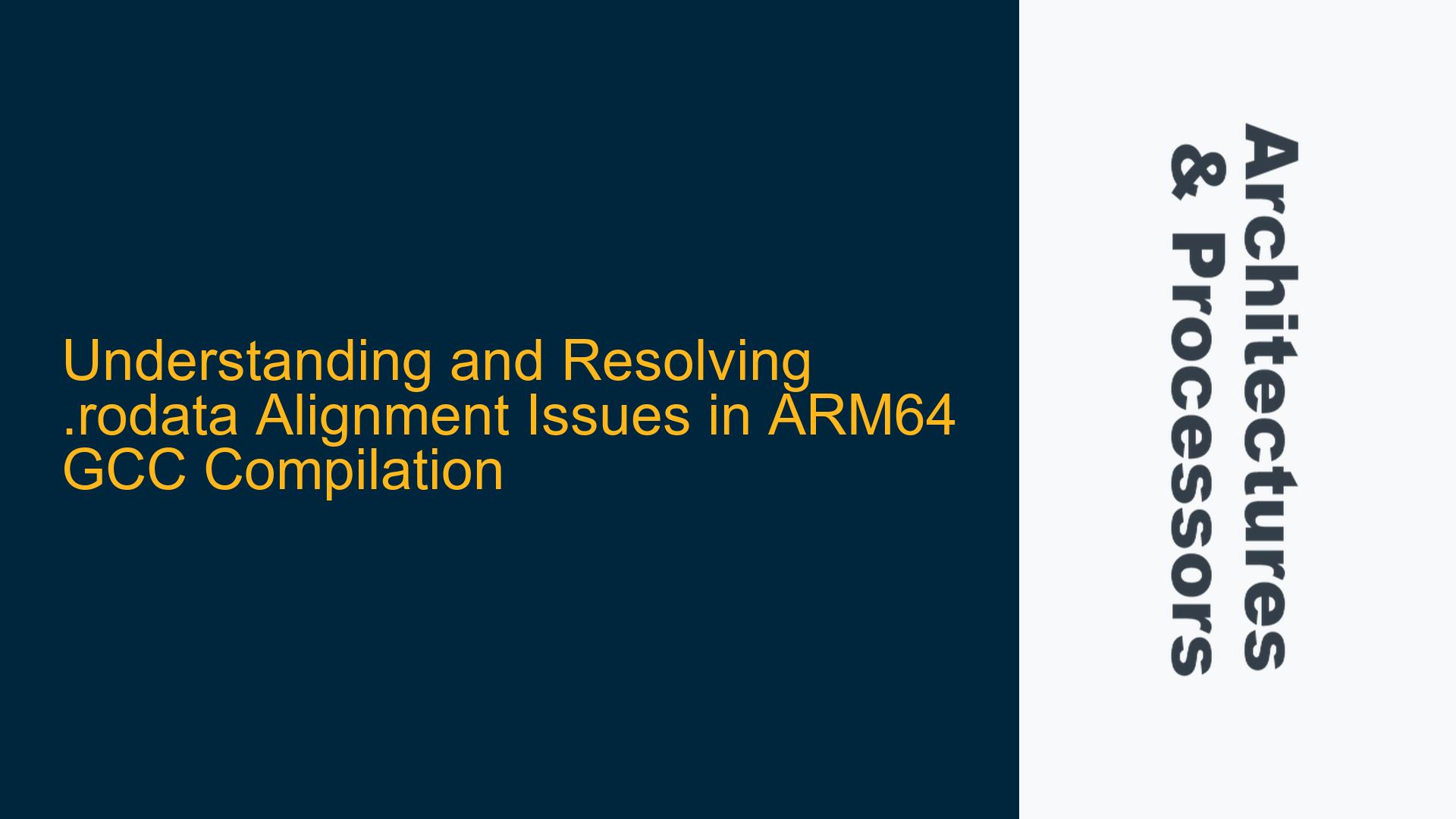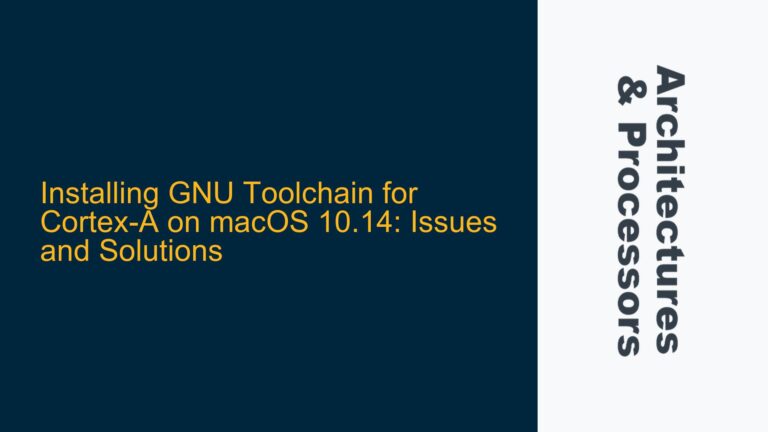ARM64 GCC Doubleword Alignment for .rodata Strings
When working with ARM64 architectures, particularly on platforms like the Raspberry Pi running a 64-bit OS, developers often encounter specific alignment requirements for different sections of their code. One such section is the .rodata segment, which stores read-only data, including string literals. The alignment of these segments can significantly impact performance and compatibility, especially when dealing with different data types and access patterns.
In the context of ARM64, the GCC compiler often aligns .rodata segments, particularly string literals, to doubleword boundaries. This alignment might seem counterintuitive at first glance, especially considering that the fundamental element of a string is a byte. However, this alignment strategy is deeply rooted in the architectural optimizations and requirements of the ARM64 platform.
The alignment of .rodata segments to doubleword boundaries is primarily driven by the need to optimize memory access patterns. ARM64 processors are designed to handle data more efficiently when it is aligned to natural boundaries, which are typically the size of the processor’s word or doubleword. For ARM64, a doubleword is 8 bytes, and aligning data to these boundaries can reduce the number of memory access cycles, thereby improving performance.
Moreover, the alignment of .rodata segments to doubleword boundaries also facilitates better cache utilization. Modern ARM64 processors employ sophisticated caching mechanisms that rely on data being aligned to specific boundaries to maximize cache line utilization. Misaligned data can lead to cache line splits, where a single cache line contains parts of two different data structures, leading to inefficiencies and potential performance bottlenecks.
Another critical aspect to consider is the interaction between the .rodata segment and other sections of the program, such as the .text segment, which contains the executable code. The alignment of these segments must be carefully managed to ensure that the processor can efficiently fetch and execute instructions while accessing the necessary data. Misalignment between these segments can lead to increased latency and reduced throughput, particularly in systems with tight performance constraints.
In summary, the doubleword alignment of .rodata segments in ARM64 GCC compilation is a deliberate optimization strategy aimed at enhancing memory access efficiency, improving cache utilization, and ensuring seamless interaction between different program segments. Understanding this alignment requirement is crucial for developers working on ARM64 platforms, as it directly impacts the performance and reliability of their applications.
Memory Access Optimization and Cache Utilization in ARM64
The alignment of .rodata segments to doubleword boundaries in ARM64 GCC compilation is not arbitrary; it is a carefully considered decision driven by the need to optimize memory access patterns and cache utilization. To fully grasp the rationale behind this alignment strategy, it is essential to delve into the intricacies of memory access optimization and cache management in ARM64 architectures.
ARM64 processors are designed to handle data in chunks that align with their natural word size, which is 8 bytes (doubleword) for 64-bit architectures. When data is aligned to these natural boundaries, the processor can access it more efficiently, often in a single memory cycle. Conversely, misaligned data may require multiple memory cycles to fetch, as the processor needs to access two separate memory locations and then combine the results. This inefficiency can significantly impact performance, especially in applications with high memory throughput requirements.
Cache utilization is another critical factor influencing the alignment of .rodata segments. ARM64 processors typically employ multi-level cache hierarchies, including L1, L2, and sometimes L3 caches. These caches are organized into cache lines, which are fixed-size blocks of memory that are loaded and evicted as a unit. The size of a cache line varies between processor models but is often 64 bytes. When data is aligned to doubleword boundaries, it is more likely to fit neatly within cache lines, reducing the likelihood of cache line splits and improving cache efficiency.
Cache line splits occur when a single cache line contains parts of two different data structures. For example, if a string literal is not aligned to a doubleword boundary, it might span two cache lines. This scenario forces the processor to load two cache lines to access a single string, leading to increased memory bandwidth usage and potential cache thrashing. By aligning .rodata segments to doubleword boundaries, the compiler minimizes the risk of cache line splits, ensuring that each cache line is utilized effectively.
Furthermore, the alignment of .rodata segments to doubleword boundaries also facilitates better prefetching behavior. ARM64 processors often employ hardware prefetchers that predict which memory locations will be accessed next and load them into the cache in advance. When data is aligned to natural boundaries, the prefetcher can more accurately predict access patterns, leading to more effective prefetching and reduced latency.
In addition to memory access optimization and cache utilization, the alignment of .rodata segments also plays a crucial role in ensuring compatibility with various ARM64 microarchitectures. Different ARM64 processors may have varying requirements and optimizations related to data alignment. By adhering to doubleword alignment, the compiler ensures that the generated code is compatible with a wide range of ARM64 processors, providing a consistent performance profile across different hardware implementations.
In conclusion, the doubleword alignment of .rodata segments in ARM64 GCC compilation is a multifaceted optimization strategy that enhances memory access efficiency, improves cache utilization, and ensures compatibility across different ARM64 microarchitectures. Developers working on ARM64 platforms must be aware of these alignment requirements to maximize the performance and reliability of their applications.
Implementing Proper Alignment Strategies in ARM64 GCC Compilation
To effectively implement proper alignment strategies in ARM64 GCC compilation, developers must understand the underlying mechanisms and tools available for controlling data alignment. This section provides a detailed guide on how to manage alignment in the .rodata segment, ensuring optimal performance and compatibility on ARM64 platforms.
The first step in managing alignment is to understand the directives provided by the GCC compiler for controlling section alignment. The .align directive is commonly used to specify the alignment boundary for a section or data structure. In the context of .rodata segments, the .align 3 directive is used to align data to an 8-byte (doubleword) boundary. This directive ensures that the subsequent data is placed at an address that is a multiple of 8, aligning with the natural word size of the ARM64 architecture.
For example, consider the following assembly code snippet:
.section .rodata
.align 3
.LC0:
.string "Enter one character: "
.align 3
.LC1:
.string "You entered: "
.text
.align 2
.global main
.type main, %function
main:
In this snippet, the .align 3 directive is used to align the string literals .LC0 and .LC1 to doubleword boundaries. This alignment ensures that the strings are stored at addresses that are multiples of 8, optimizing memory access and cache utilization.
In addition to the .align directive, developers can also use the -falign-functions and -falign-labels compiler options to control the alignment of functions and labels, respectively. These options can be particularly useful when fine-tuning the alignment of specific code sections to achieve optimal performance.
Another important consideration is the interaction between the .rodata segment and other sections of the program, such as the .text segment. Proper alignment of these segments is crucial to ensure that the processor can efficiently fetch and execute instructions while accessing the necessary data. Misalignment between these segments can lead to increased latency and reduced throughput, particularly in systems with tight performance constraints.
To manage the alignment of multiple sections, developers can use linker scripts to specify the layout of memory segments. Linker scripts provide fine-grained control over the placement and alignment of sections, allowing developers to optimize the memory layout for their specific application. For example, the following linker script snippet ensures that the .rodata segment is aligned to a doubleword boundary:
SECTIONS
{
.rodata ALIGN(8) : {
*(.rodata)
}
.text ALIGN(4) : {
*(.text)
}
}
In this snippet, the .rodata segment is aligned to an 8-byte boundary, while the .text segment is aligned to a 4-byte boundary. This alignment strategy ensures that both segments are optimally placed in memory, minimizing latency and maximizing performance.
Finally, developers should be aware of the potential impact of alignment on debugging and profiling. Misaligned data can lead to unexpected behavior and performance issues that are difficult to diagnose. By adhering to proper alignment strategies, developers can simplify the debugging process and ensure that their applications perform as expected.
In conclusion, implementing proper alignment strategies in ARM64 GCC compilation involves a combination of compiler directives, linker scripts, and careful consideration of memory layout. By aligning .rodata segments to doubleword boundaries and managing the alignment of other sections, developers can optimize memory access, improve cache utilization, and ensure compatibility across different ARM64 microarchitectures. These strategies are essential for maximizing the performance and reliability of applications on ARM64 platforms.






